Study on the Spatial Distribution Characteristics and Influencing Factors in the Reuse of National Industrial Heritage Sites in China
Abstract
:1. Introduction
2. Materials and Methods
2.1. Data Sources
2.2. Data Processing
- Industrial Heritage Data Collection: Information on industrial heritage was gathered based on publicly disclosed catalogs providing names and addresses of heritage sites. Geographic coordinates were obtained by the Baidu Map API coordinate picker.
- Calibration of Heritage Geographic Coordinates Coordinated with Google Earth and Imported into ArcGIS 10.8: The geographic coordinates of heritage sites were calibrated in coordination with Google Earth. The calibrated data were subsequently imported into ArcGIS 10.8. Considering the spatial structure of industrial heritage, especially for area-based heritage or linear heritage, the most representative heritage points were selected as reference points for geographic spatial location calibration (e.g., the Harbin Forestry Bureau was used as a reference point for the Harbin–Hailin Railway).
- Integration of Official Government Websites and Web Content Related to Heritage Reuse: Official government websites and relevant web content on heritage reuse were integrated. Directional categorization and statistical analysis of reuse for different regions and types of heritage sites were conducted. Excel 2016 was utilized for data organization and bar graph creation, employing one-way analysis of variance (ANOVA) to test differences.
- Attribute Identification in ArcGIS Settings: In the ArcGIS settings, clear identification of attributes, including names and types, for each heritage point was provided in the attribute table. This facilitated digitized operations and spatial analysis.
2.3. Methods
2.3.1. Nearest Neighbor Index
2.3.2. Geographic Concentration Index
2.3.3. Kernel Density
2.3.4. Geographic Detector
3. Results
3.1. Overall Spatial Distribution of NIH Sites
3.1.1. Type of Spatial Distribution
3.1.2. Spatial Distribution Density
3.2. Spatial Distribution Characteristics of the Number of Reused NIH Sites
3.2.1. NIH Reuse in Different Regions
3.2.2. NIH Reuse of Different Types
3.3. Spatial Distribution Characteristics of the Direction of Reused NIH Sites
3.3.1. Classification of Reuse Direction
3.3.2. Regional Differentiation Characteristics
- Reuse in the direction of industrialization
- Reuse in the direction of public spatialization
4. Factors Influencing the Spatial Distribution of Reuse Heritage Sites
4.1. Influencing Factors
4.2. Analysis of Influencing Factors
4.2.1. Natural Geography
4.2.2. Socioeconomics
4.2.3. Tourism Resources
4.2.4. Government Support
4.3. Integrated Impact Mechanism
5. Discussion
6. Conclusions
- China’s NIH sites exhibit an uneven yet cohesive spatial distribution. They form a densely populated circle, with the core regions being the Yangtze River Delta and the Beijing–Tianjin–Hebei region.
- Approximately three-quarters of China’s NIH sites are already in the reuse stage, with high-density clusters in the eastern and central regions. The heritage types are relatively diverse, with heavy industrial types outnumbering light industrial and municipal construction types. Light industrial types represent the largest proportion of reuse, followed by heavy industrial and municipal construction types.
- The conservation and reuse of NIH sites can be categorized into two main approaches: public- and market-oriented. Regarding regional differences, there is a greater prevalence of public cultural facility-based conservation and reuse of NIH sites in the eastern region than in the central and western regions. Among public cultural facility-based types, museums occupy a dominant position.
- The spatial differentiation of reused NIH sites results from multiple factors. Both physical geography and socioeconomics exert varying degrees of influence on the spatial distribution of reused heritage sites. Additionally, policy regimes and tourism resources play pivotal roles in shaping this spatial differentiation.
Author Contributions
Funding
Institutional Review Board Statement
Informed Consent Statement
Data Availability Statement
Acknowledgments
Conflicts of Interest
References
- Hain, V.; Ganobjak, M. Forgotten Industrial Heritage in Virtual Reality—Case Study: Old Power Plant in Piešt’any, Slovakia. Presence Teleoperators Virtual Environ. 2017, 26, 355–365. [Google Scholar] [CrossRef]
- Ikiz Kaya, D.; Pintossi, N.; Dane, G. An Empirical Analysis of Driving Factors and Policy Enablers of Heritage Adaptive Reuse within the Circular Economy Framework. Sustainability 2021, 13, 2479. [Google Scholar] [CrossRef]
- Aydın, E.Ö.; Tepe, E.; Balcan, C. Identification of Determinants during the Registration Process of Industrial Heritage Using a Regression Analysis. J. Cult. Herit. 2022, 58, 23–32. [Google Scholar] [CrossRef]
- Bai, S.; Chen, Y. A Preliminary Discussion of the Connotations of “Industrial Heritage” in the Chinese Context: On the different translations of “Industrial Heritage” between China and Japan. Southeast Cult. 2022, 2, 13–15. [Google Scholar]
- Garza-Rodríguez, F.; Roca, E.; Villares, M. Cultura Local y Regeneración Urbana: Un Caso de Estudio En Monterrey, Nuevo León. Estud. Demográficos Urbanos 2020, 35, 761–801. [Google Scholar] [CrossRef]
- Kim, G.; Newman, G.; Jiang, B. Urban Regeneration: Community Engagement Process for Vacant Land in Declining Cities. Cities 2020, 102, 102730. [Google Scholar] [CrossRef]
- Peponi, A.; Morgado, P. Smart and Regenerative Urban Growth: A Literature Network Analysis. Int. J. Environ. Res. Public Health 2020, 17, 2463. [Google Scholar] [CrossRef] [PubMed]
- Huang, L.; Zheng, W.; Hong, J.; Liu, Y.; Liu, G. Paths and Strategies for Sustainable Urban Renewal at the Neighbourhood Level: A Framework for Decision-Making. Sustain. Cities Soc. 2020, 55, 102074. [Google Scholar] [CrossRef]
- Li, Z.; Gai, Q.; Qin, L. Superimposed Renewal of Industrial Heritage under the Guidance of Low Maintenance and Sustainability—Renewal of Refinery Site in Jinan Tianhong Community. Sustainability 2022, 14, 7486. [Google Scholar] [CrossRef]
- Lee, W.; Shin, S.; Jang, S. Sustainable Urban Regeneration Strategies in Korea’s Abandoned Mine Area Using Industrial Heritage. Adv. Civ. Eng. 2022, 2022, 7401027. [Google Scholar] [CrossRef]
- Vukmirović, M.; Nikolić, M. Industrial Heritage Preservation and the Urban Revitalization Process in Belgrade. J. Urban Aff. 2023, 45, 191–216. [Google Scholar] [CrossRef]
- Galaz-Mandakovic, D.; Rivera, F. The Industrial Heritage of Two Sacrifice Zones and the Geopolitics of Memory in Northern Chile. The Cases of Gatico and Ollagüe. Int. J. Herit. Stud. 2023, 29, 243–259. [Google Scholar] [CrossRef]
- Nikolić, M.; Drobnjak, B.; Kuletin Ćulafić, I. The Possibilities of Preservation, Regeneration and Presentation of Industrial Heritage: The Case of Old Mint “A.D.” on Belgrade Riverfront. Sustainability 2020, 12, 5264. [Google Scholar] [CrossRef]
- Fan, X.; Dai, S. Spatial–Temporal Distribution Characteristics of Industrial Heritage Protection and the Influencing Factors in a Chinese City: A Case Study of the Tiexi Old Industrial District in Shenyang. J. Herit. Tour. 2017, 12, 281–295. [Google Scholar] [CrossRef]
- Chen, J.; Judd, B. Relationality and Territoriality: Rethinking Policy Circulation of Industrial Heritage Reuse in Chongqing, China. Int. J. Herit. Stud. 2021, 27, 16–38. [Google Scholar] [CrossRef]
- Peng, W.; Kuang, T.; Tao, S. Quantifying influences of natural factors on vegetation NDVI changes based on geographical detector in Sichuan, western China. J. Clean. Prod. 2019, 233, 353–367. [Google Scholar] [CrossRef]
- Wang, T.; Li, Y.; Li, H.; Chen, S.; Li, H.; Zhang, Y. Research on the Vitality Evaluation of Parks and Squares in Medium-Sized Chinese Cities from the Perspective of Urban Functional Areas. Int. J. Environ. Res. Public Health 2022, 19, 15238. [Google Scholar] [CrossRef]
- Zhao, W.; Zhou, B. Out of the Dilemma: Industrial Heritage Value Evaluation and Renewal Suitability Research in Chengdu, China. J. Urban Plan. Dev. 2022, 148, 04022004. [Google Scholar] [CrossRef]
- Mo, C.; Wang, L.; Rao, F. Typology, Preservation, and Regeneration of the Post-1949 Industrial Heritage in China: A Case Study of Shanghai. Land 2022, 11, 1527. [Google Scholar] [CrossRef]
- Zeng, Q.; Lee, M.; Eune, J. Digital Design Method of Cultural Heritage Using Ancient Egyptian Theological Totem. Heliyon 2023, 9, e15960. [Google Scholar] [CrossRef]
- Deufemia, V.; Paolino, L.; Tortora, G.; Traverso, A.; Mascardi, V.; Ancona, M.; Martelli, M.; Bianchi, N.; Lumley, H.D. Investigative Analysis across Documents and Drawings: Visual Analytics for Archaeologists. In Proceedings of the International Working Conference on Advanced Visual Interfaces, Naples, Italy, 22–25 May 2012; pp. 539–546. [Google Scholar]
- Zhang, J.; Kang, K.; Liu, D.; Yuan, Y.; Yanli, E. Vis4Heritage: Visual Analytics Approach on Grotto Wall Painting Degradations. IEEE Trans. Vis. Comput. Graph. 2013, 19, 1982–1991. [Google Scholar] [CrossRef] [PubMed]
- Dimitropoulos, K.; Tsalakanidou, F.; Nikolopoulos, S.; Kompatsiaris, I.; Grammalidis, N.; Manitsaris, S.; Denby, B.; Crevier-Buchman, L.; Dupont, S.; Charisis, V.; et al. A Multimodal Approach for the Safeguarding and Transmission of Intangible Cultural Heritage: The Case of i-Treasures. IEEE Intell. Syst. 2018, 33, 3–16. [Google Scholar] [CrossRef]
- Qin, L.; Chen, S.; Huang, J.; Lin, H. Statistical System of Cultural Heritage Tourism Information Based on Image Feature Extraction Technology. Math. Probl. Eng. 2022, 2022, 5250853. [Google Scholar] [CrossRef]
- Liu, C.; Kang, L. How Do Geographical Factors Affect the Distribution of Intangible Cultural Heritage: A Case Study of Xinjiang, China. Sustainability 2023, 15, 8943. [Google Scholar] [CrossRef]
- Nie, X.; Ma, M.; Ji, J.; Zheng, L. The Spatial Distribution of Traditional Intangible Cultural Heritage Medicine of China and Its Influencing Factors. Herit. Sci. 2023, 11, 90. [Google Scholar] [CrossRef]
- Ding, N.; Zhai, Y.; Lv, H. Crime Risk Analysis of Tangible Cultural Heritage in China from a Spatial Perspective. ISPRS Int. J. Geo-Inf. 2023, 12, 201. [Google Scholar] [CrossRef]
- Fag U Ndez, J.; Izco, J.U.S. Spatial analysis of heath toponymy in relation to present-day heathland distribution. Int. J. Geogr. Inf. Sci. 2016, 30, 51–60. [Google Scholar] [CrossRef]
- Chang, B.; Ding, X.; Xi, J.; Zhang, R.; Lv, X. Spatial-Temporal Distribution Pattern and Tourism Utilization Potential of Intangible Cultural Heritage Resources in the Yellow River Basin. Sustainability 2023, 15, 2611. [Google Scholar] [CrossRef]
- Ciski, M.; Rząsa, K.; Ogryzek, M. Use of GIS Tools in Sustainable Heritage Management—The Importance of Data Generalization in Spatial Modeling. Sustainability 2019, 11, 5616. [Google Scholar] [CrossRef]
- Meng, L.; Zhu, C.; Pu, J.; Wen, B.; Si, W. Study on the Influence Mechanism of Intangible Cultural Heritage Distribution from Man–Land Relationship Perspective: A Case Study in Shandong Province. Land 2022, 11, 1225. [Google Scholar] [CrossRef]
- Nie, X.; Xie, Y.; Xie, X.; Zheng, L. The characteristics and influencing factors of the spatial distribution of intangible cultural heritage in the Yellow River Basin of China. Herit. Sci. 2022, 10, 121. [Google Scholar] [CrossRef]
- Cai, P. Spatial Differentiation of Intangible Cultural Heritage in South China and Its Influencing Factors. Wirel. Commun. Mob. Comput. 2022, 2022, e7714161. [Google Scholar] [CrossRef]
- Hashimoto, S.; Nakamura, S.; Saito, O.; Kohsaka, R.; Kamiyama, C.; Tomiyoshi, M.; Kishioka, T. Mapping and characterizing ecosystem services of social–ecological production landscapes: Case study of Noto, Japan. Sustain. Sci. 2015, 10, 257–273. [Google Scholar] [CrossRef]
- Wang, F.; Mao, W.; Dong, Y.; Zhu, X. Implications for cultural landscape in a Chinese context: Geo-analysis of spatial distribution of historic sites. Chin. Geogr. Sci. 2018, 28, 167–182. [Google Scholar] [CrossRef]
- Yao, Y.; Wang, X.; Lu, L.; Liu, C.; Wu, Q.; Ren, H.; Yang, S.; Sun, R.; Luo, L.; Wu, K. Proportionated Distributions in Spatiotemporal Structure of the World Cultural Heritage Sites: Analysis and Countermeasures. Sustainability 2021, 13, 2148. [Google Scholar] [CrossRef]
- Sun, J. Intangible Cultural Heritage Management and Protection Based on Spatial Information Technology under the Background of Internet of Things. Comput. Intell. Neurosci. 2022, 2022, 4941617. [Google Scholar] [CrossRef] [PubMed]
- Wang, X.; Zhan, S. Exploring the Spatial Distribution of ICH by Geographic Information System (GIS). Mob. Inf. Syst. 2022, 2022, 8689113. [Google Scholar] [CrossRef]
- Serrano-Lopez, R.; Manso, J.M.; Martinez-Martinez, J.A.; Payo, R.J. The aesthetic “senses” of heritage: Metallic building before welding development. Examples in Burgos and Palencia (Spain). Inf. Constr. 2012, 64, 457–470. [Google Scholar]
- Pereira, V.S. Preserve, demolish, build or squat the daycare Ninho Jardim Condessa Marina R. Crespi: Of all risks, the risk. Estud. Históricos. Rio. Jan. 2016, 29, 107–128. [Google Scholar]
- De Gregorio, S.; De Vita, M.; De Berardinis, P.; Palmero, L.; Risdonne, A. Designing the Sustainable Adaptive Reuse of Industrial Heritage to Enhance the Local Context. Sustainability 2020, 12, 9059. [Google Scholar] [CrossRef]
- Ionica, A.; Samuil, I.; Leba, M.; Toderas, M. The Path of Petrila Mining Area towards Future Industrial Heritage Tourism Seen through the Lenses of Past and Present. Sustainability 2020, 12, 9922. [Google Scholar] [CrossRef]
- Fusco Girard, L.; Vecco, M. The “Intrinsic Value” of Cultural Heritage as Driver for Circular Human-Centered Adaptive Reuse. Sustainability 2021, 13, 3231. [Google Scholar] [CrossRef]
- Roszczynska-Kurasinska, M.; Domaradzka, A.; Wnuk, A.; Oleksy, T. Intrinsic Value and Perceived Essentialism of Culture Heritage Sites as Tools for Planning Interventions. Sustainability 2021, 13, 5078. [Google Scholar] [CrossRef]
- Merciu, F.-C.; Păunescu, C.; Merciu, G.-L.; Cioacă, A.E. Using 3D Modeling to Promote Railway Heritage. The Railway Station of Curtea De Argeş Municipality as Case Study. J. Appl. Eng. Sci. 2021, 11, 121–126. [Google Scholar] [CrossRef]
- Xie, P.F. Developing Industrial Heritage Tourism: A Case Study of the Proposed Jeep Museum in Toledo, Ohio. Tour. Manag. 2006, 27, 1321–1330. [Google Scholar] [CrossRef]
- Henriques, M.H.; Canales, M.L.; García-Frank, A.; Gomez-Heras, M. Accessible Geoparks in Iberia: A Challenge to Promote Geotourism and Education for Sustainable Development. Geoheritage 2019, 11, 471–484. [Google Scholar] [CrossRef]
- Liu, F.; Zhao, Q.; Yang, Y. An Approach to Assess the Value of Industrial Heritage Based on Dempster–Shafer Theory. J. Cult. Herit. 2018, 32, 210–220. [Google Scholar] [CrossRef]
- Zhang, J.; Sun, H.; Xu, S.; Aoki, N. Analysis of the Spatial and Temporal Distribution and Reuse of Urban Industrial Heritage: The Case of Tianjin, China. Land 2022, 11, 2273. [Google Scholar] [CrossRef]
- Zhang, J.; Cenci, J.; Becue, V.; Koutra, S.; Liao, C. Stewardship of Industrial Heritage Protection in Typical Western European and Chinese Regions: Values and Dilemmas. Land 2022, 11, 772. [Google Scholar] [CrossRef]
- Sun, B.; Ikebe, K. Characteristics of Heritage of Industrial Modernization and Urban Spatial Distribution in Shenyang, China. J. Asian Arch. Build. Eng. 2023, 22, 1823–1840. [Google Scholar] [CrossRef]
- Wang, F.-F.; Zhang, J.-Y.; Yoon, J.-Y. A Study on the Evaluation of Placeness of Industrial Heritages Space with Cultural Characteristics-Focused on Beijing 798 Art Zone in China. Korean Inst. Inter. Des. J. 2017, 26, 101–113. [Google Scholar] [CrossRef]
- Lu, N.; Liu, M.; Wang, R. Reproducing the Discourse on Industrial Heritage in China: Reflections on the Evolution of Values, Policies and Practices. Int. J. Herit. Stud. 2020, 26, 498–518. [Google Scholar] [CrossRef]
- Han, S.H.; Zhang, H. Progress and Prospects in Industrial Heritage Reconstruction and Reuse Research during the Past Five Years: Review and Outlook. Land 2022, 11, 2119. [Google Scholar] [CrossRef]
- Zhang, J.; Cenci, J.; Becue, V.; Koutra, S. Analysis of Spatial Structure and Influencing Factors of the Distribution of National Industrial Heritage Sites in China Based on Mathematical Calculations. Environ. Sci. Pollut. Res. 2022, 29, 27124–27139. [Google Scholar] [CrossRef]
- Zhao, Q.; Li, H. Research on spatial differentiation characteristics and formation mechanism of national industrial Heritages. Urban Probl. 2022, 11, 54–64. [Google Scholar]
- Notice of the Ministry of Industry and Information Technology on the Issuance of the National Industrial Heritage Management Measures. Available online: https://wap.miit.gov.cn/zwgk/zcwj/wjfb/tz/art/2023/art_0e305c01a0d14f8fbada2924c26ebdb2.html (accessed on 19 March 2023).
- Chang, H. Research on Spatial Distribution of National level Industrial and Cultural Heritage in China. Master’s Thesis, Hunan Normal University, Changsha, China, 2021. [Google Scholar]
- Zhou, Y.; Huang, H.; Liu, Y. The spatial distribution characteristics and influencing factors of Chinese villages. Acta Geogr. Sin. 2020, 75, 2206–2223. [Google Scholar]
- Zhang, S.; Zhang, G.; Ju, H. The Spatial Pattern and Influencing Factors of Tourism Development in the Yellow River Basin of China. PLoS ONE 2020, 15, e0242029. [Google Scholar] [CrossRef] [PubMed]
- Zhang, A.; Yang, Y.; Chen, T.; Liu, J.; Hu, Y. Exploration of Spatial Differentiation Patterns and Related Influencing Factors for National Key Villages for Rural Tourism in China in the Context of a Rural Revitalization Strategy, Using GIS-Based Overlay Analysis. Arab. J. Geosci. 2021, 14, 83. [Google Scholar] [CrossRef]
- Yang, Q.; Zhang, F.; An, Y.; Sun, C.; Wu, J.; Zhang, Y.; Wei, Z. Research on the Spatial Distribution Pattern and Influencing Factors of China’s Antipoverty (Pro-Poor Tourism) on GIS. Discret. Dyn. Nat. Soc. 2021, 2021, 6682498. [Google Scholar] [CrossRef]
- Wang, J.; Li, X.; Christakos, G.; Liao, Y.; Zhang, T.; Gu, X.; Zheng, X. Geographical Detectors-Based Health Risk Assessment and Its Application in the Neural Tube Defects Study of the Heshun Region, China. Int. J. Geogr. Inf. Sci. 2010, 24, 107–127. [Google Scholar] [CrossRef]
- Clark, P.J.; Evans, F.C. Distance to Nearest Neighbor as a Measure of Spatial Relationships in Populations. Ecology 1954, 35, 445–453. [Google Scholar] [CrossRef]
- Bian, J.; Chen, W.; Zeng, J. Spatial Distribution Characteristics and Influencing Factors of Traditional Villages in China. Int. J. Environ. Res. Public Health 2022, 19, 4627. [Google Scholar] [CrossRef] [PubMed]
- Qi, J.; Lu, Y.; Han, F.; Ma, X.; Yang, Z. Spatial Distribution Characteristics of the Rural Tourism Villages in the Qinghai-Tibetan Plateau and Its Influencing Factors. Int. J. Environ. Res. Public Health 2022, 19, 9330. [Google Scholar] [CrossRef]
- Wang, J.-F.; Hu, Y. Environmental Health Risk Detection with GeogDetector. Environ. Model. Softw. 2012, 33, 114–115. [Google Scholar] [CrossRef]
- Blagojević, M.R.; Tufegdžić, A. The New Technology Era Requirements and Sustainable Approach to Industrial Heritage Renewal. Energy Build. 2016, 115, 148–153. [Google Scholar] [CrossRef]
- Florentina-Cristina, M.; George-Laurenţiu, M.; Andreea-Loreta, C.; Constantin, D.C. Conversion of Industrial Heritage as a Vector of Cultural Regeneration. Procedia-Soc. Behav. Sci. 2014, 122, 162–166. [Google Scholar] [CrossRef]
- Van Duijn, M.; Rouwendal, J.; Boersema, R. Redevelopment of Industrial Heritage: Insights into External Effects on House Prices. Reg. Sci. Urban Econ. 2016, 57, 91–107. [Google Scholar] [CrossRef]
- Xiong, X.; Wang, Y.; Ma, C.; Chi, Y. Ensuring the Authenticity of the Conservation and Reuse of Modern Industrial Heritage Architecture: A Case Study of the Large Machine Factory, China. Buildings 2023, 13, 534. [Google Scholar] [CrossRef]
- Chen, C.; Cai, Y. Advances in Conservation and Reuse of Foreign Industrial Heritage Based on Visual Knowledge Graph Analysis. Ind. Constr. 2022, 52, 34–41. [Google Scholar]
- Qiao, Z.; Zhang, X. Analysis of Research Trends on International Industrial Heritage. Packag. Eng. 2021, 42, 93–101. [Google Scholar]
- Yu, H.; Wang, K.; Xu, L. International experience and enlightenment of study of recreational utilization of industriaheritage resources. World Reg. Stud. 2019, 28, 210–220. [Google Scholar]
- Ma, X.; Yang, Z.; Zheng, J. Analysis of Spatial Patterns and Driving Factors of Provincial Tourism Demand in China. Sci. Rep. 2022, 12, 2260. [Google Scholar] [CrossRef]
- Li, X.; Yang, M.; Long, L.; Liu, M.; Liu, H.; Liu, J. Geographical Distribution and Influencing Factors of Intangible Cultural Heritage in the Three Gorges Reservoir Area. Sustainability 2023, 15, 3025. [Google Scholar] [CrossRef]
- Gao, Y.; Yang, G.; Xie, Q. Spatial-Temporal Evolution and Driving Factors of Green Building Development in China. Sustainability 2020, 12, 2773. [Google Scholar] [CrossRef]
- Yang, J.; Wang, L.; Wei, S. Spatial Variation and Its Local Influencing Factors of Intangible Cultural Heritage Development along the Grand Canal in China. Int. J. Environ. Res. Public Health 2023, 20, 662. [Google Scholar] [CrossRef] [PubMed]
- Hall, C.M. Policy Learning and Policy Failure in Sustainable Tourism Governance: From First- and Second-Order to Third-Order Change? J. Sustain. Tour. 2011, 19, 649–671. [Google Scholar] [CrossRef]
- Berta, M.; Bottero, M.; Ferretti, V. A Mixed Methods Approach for the Integration of Urban Design and Economic Evaluation: Industrial Heritage and Urban Regeneration in China. Environ. Plan. B Urban Anal. City Sci. 2018, 45, 208–232. [Google Scholar] [CrossRef]
- Kuang, R.; Zuo, Y.; Gao, S.; Yin, P.; Wang, Y.; Zhang, Z.; Cai, S.; Li, N. Research on the Spatial Distribution Characteristics and Influencing Factors of Central China’s Intangible Cultural Heritage. Sustainability 2023, 15, 5751. [Google Scholar] [CrossRef]



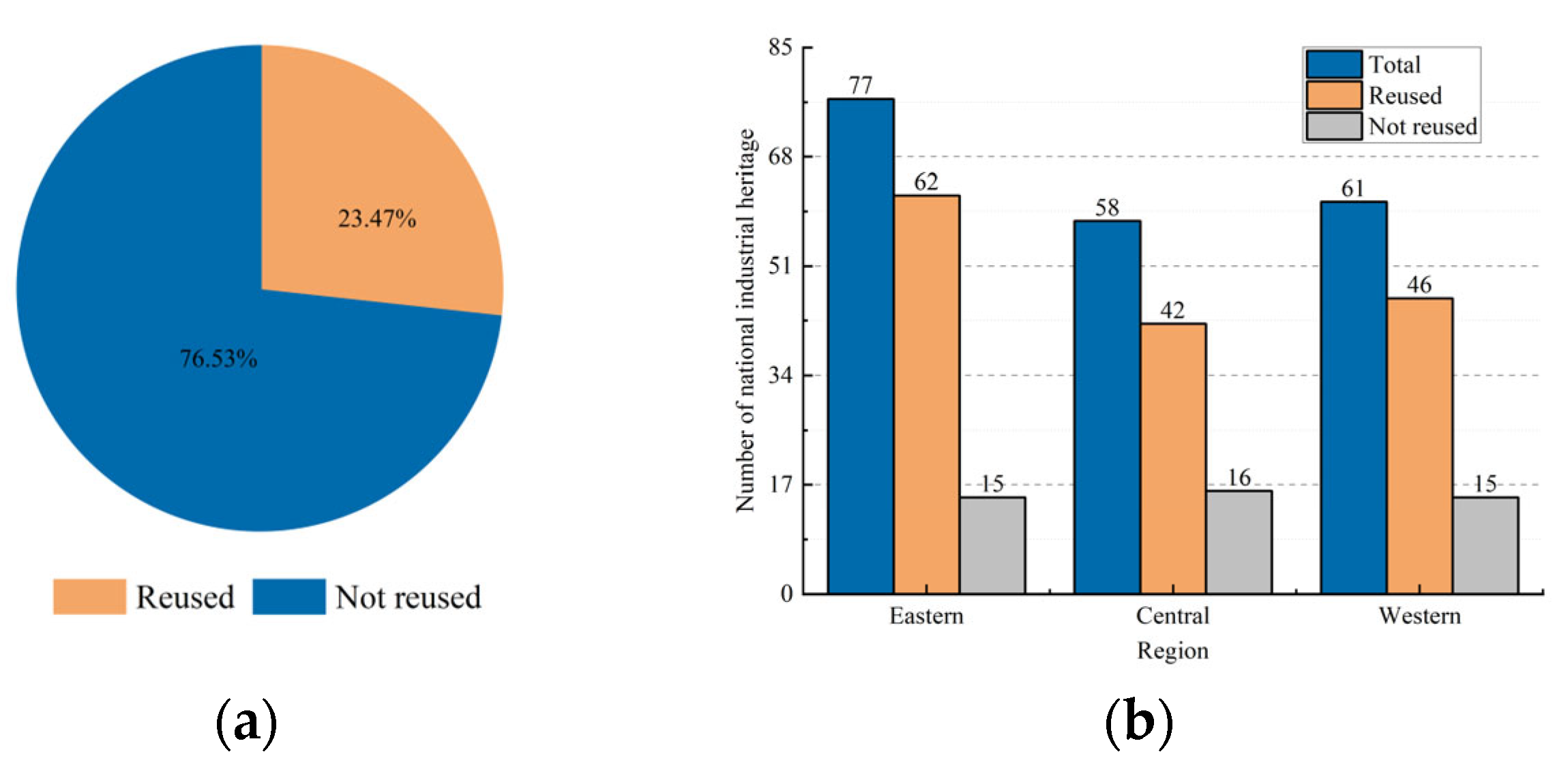
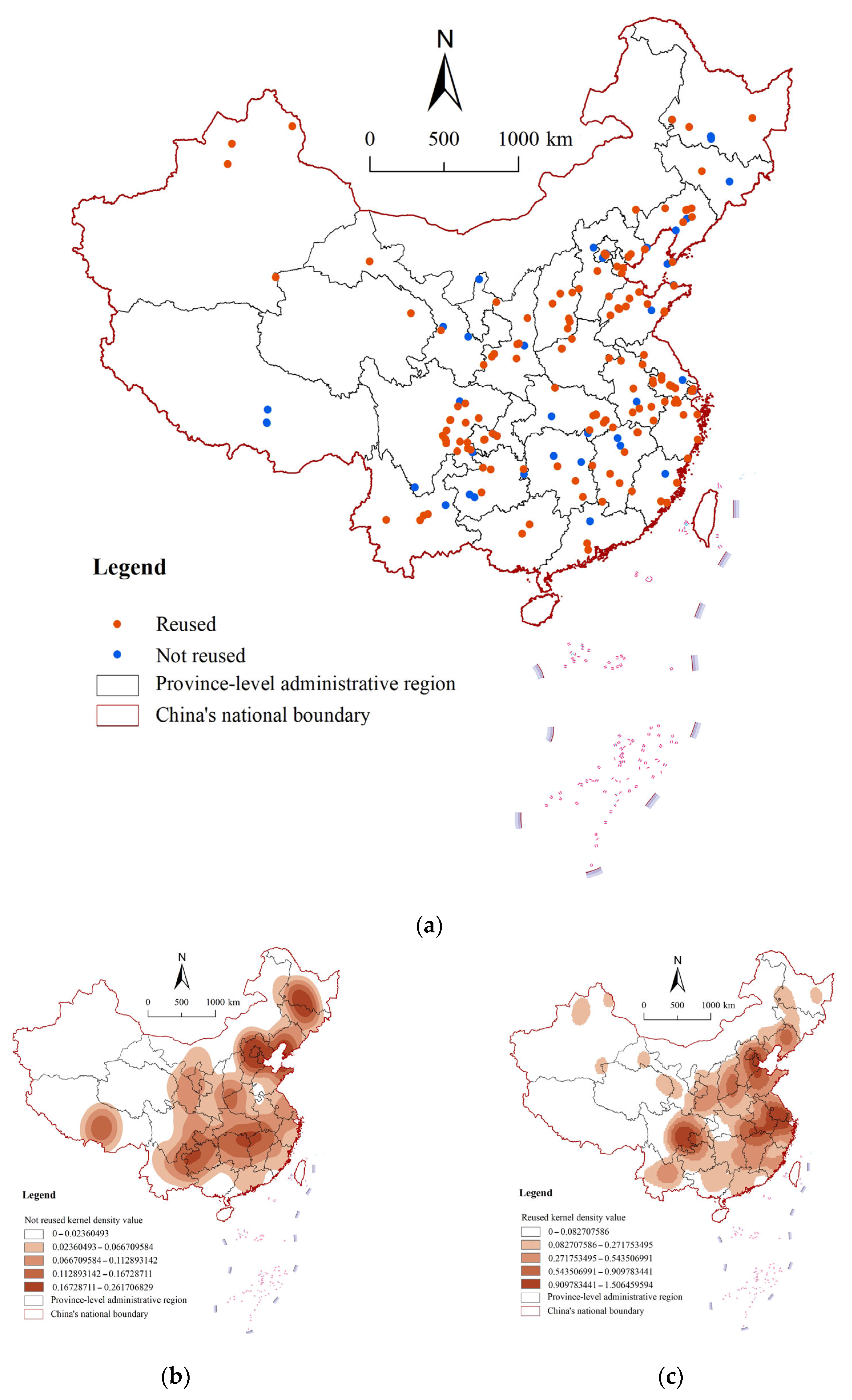

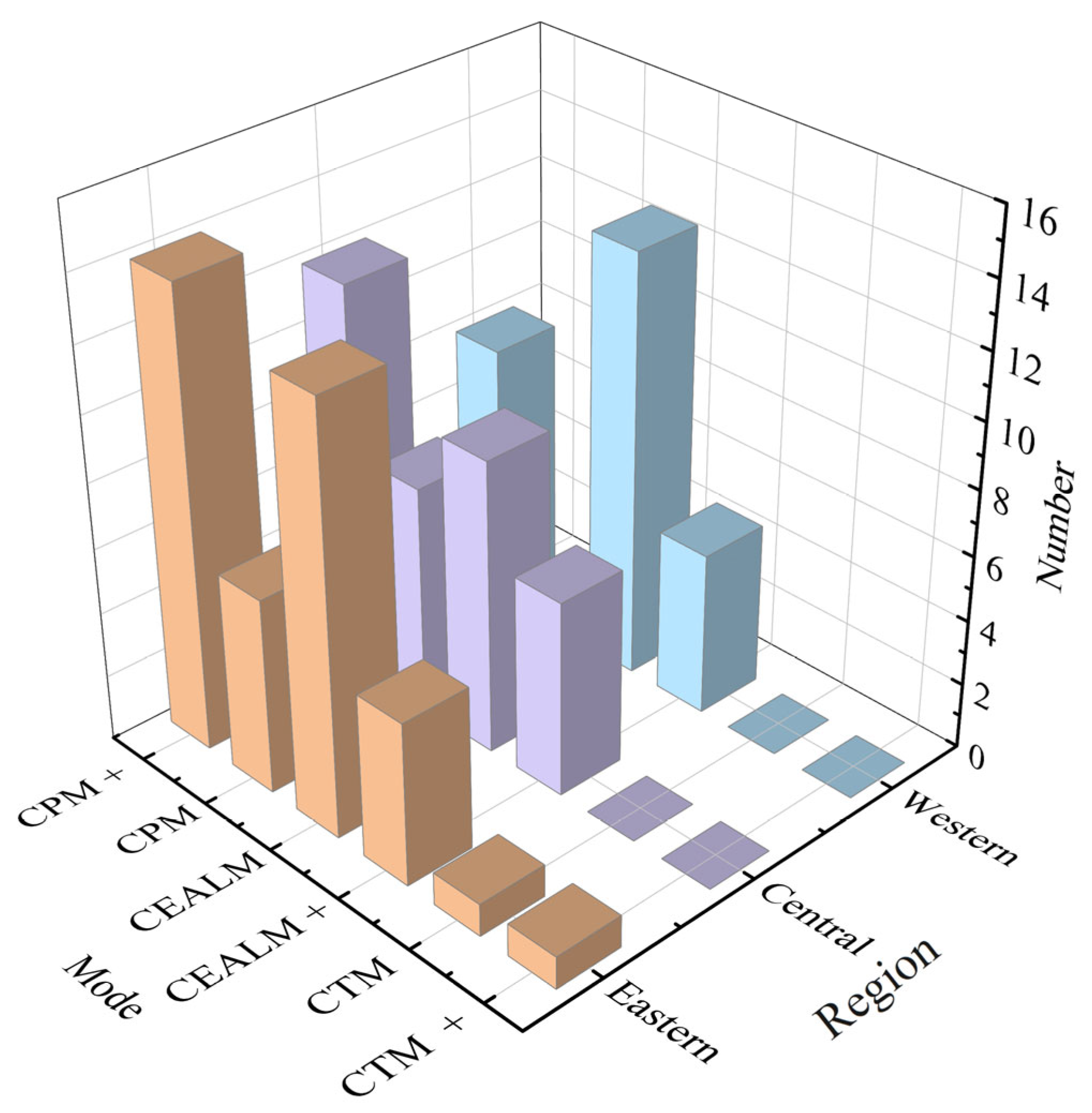
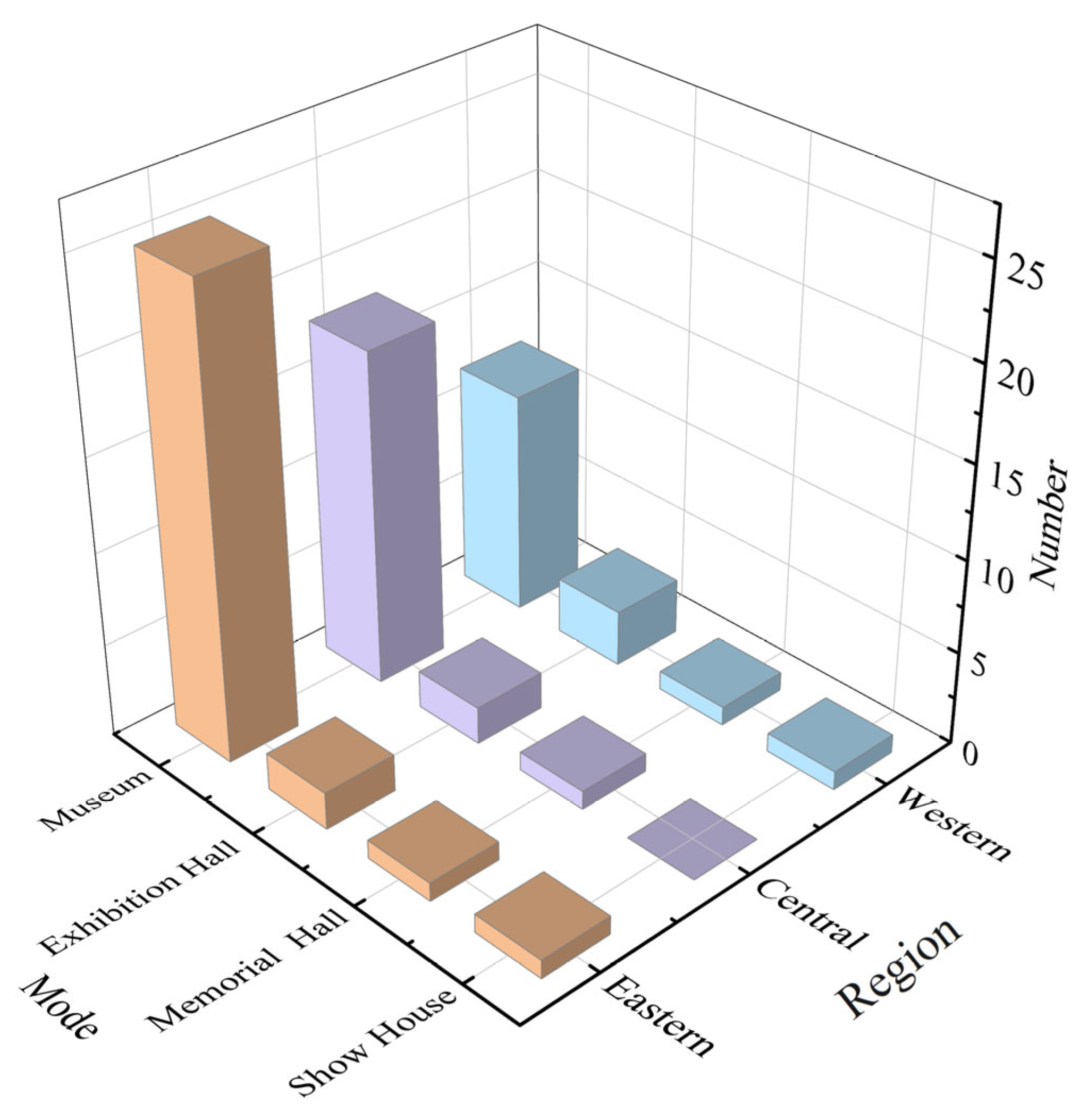

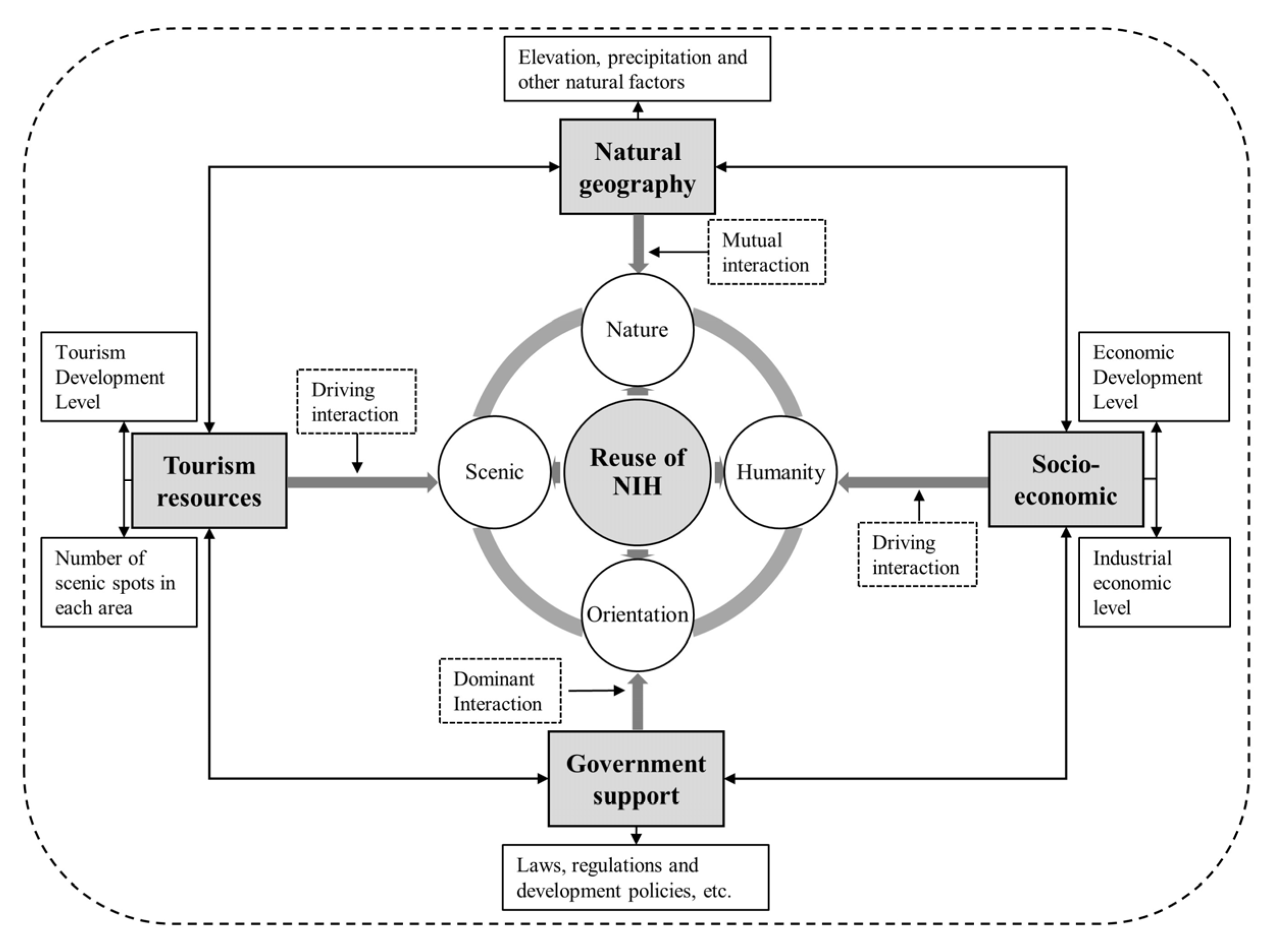
| Number | Criteria | Types |
|---|---|---|
| 1 | Industry Type | Light Industry |
| Heavy Industry | ||
| Municipal Construction | ||
| 2 | Reuse Model | Marketization: Industrialization of Capital |
| Publicization: Public Spatialization | ||
| 3 | Geographic Zoning | Eastern |
| Central | ||
| Western |
| Eastern | Sites | Reuse | Central | Sites | Reuse | Western | Sites | Reuse |
|---|---|---|---|---|---|---|---|---|
| Shandong | 14 | 13 | Jiangxi | 12 | 10 | Sichuan | 19 | 16 |
| Liaoning | 12 | 8 | Hubei | 10 | 9 | Shanxi | 9 | 8 |
| Jiangsu | 11 | 10 | Anhui | 9 | 7 | Yunnan | 6 | 5 |
| Beijing | 9 | 5 | Heilongjiang | 8 | 3 | Guizhou | 6 | 4 |
| Hebei | 9 | 7 | Shanxi | 6 | 6 | Chongqing | 5 | 4 |
| Zhejiang | 7 | 7 | Hunan | 6 | 3 | Gansu | 4 | 2 |
| Fujian | 5 | 4 | Henan | 5 | 3 | Xinjiang | 3 | 3 |
| Shanghai | 4 | 3 | Jilin | 2 | 1 | Tibet | 3 | 0 |
| Guangdong | 3 | 2 | Qinghai | 2 | 2 | |||
| Tianjin | 3 | 3 | Guangxi | 2 | 2 | |||
| Inner Mongolia | 1 | 0 | ||||||
| Ningxia | 1 | 0 | ||||||
| Total | 77 | 62 | Total | 58 | 42 | Total | 61 | 46 |
| Reuse rate | 0.81 | Reuse rate | 0.72 | Reuse rate | 0.75 | |||
| Classification | Type | Total Number | Reuse | Proportion |
|---|---|---|---|---|
| Light Industry | Brewing | 21 | 18 | 0.86 |
| Textile | 11 | 10 | 0.91 | |
| Ceramics | 8 | 8 | 1.00 | |
| Food | 7 | 5 | 0.71 | |
| Tea Making | 6 | 3 | 0.50 | |
| Stationery Tools | 4 | 3 | 0.75 | |
| Tobacco | 2 | 1 | 0.50 | |
| Flour | 2 | 2 | 1.00 | |
| Home Appliances | 2 | 2 | 1.00 | |
| Culture | 2 | 2 | 1.00 | |
| Printing | 1 | 1 | 1.00 | |
| Subtotal | 66 | 55 | 0.83 | |
| Heavy Industry | Mining and Metallurgy | 28 | 23 | 0.82 |
| Machinery | 16 | 11 | 0.69 | |
| Building Materials | 15 | 12 | 0.80 | |
| Kernel Industry | 9 | 6 | 0.67 | |
| Oil | 8 | 8 | 1.00 | |
| Chemical | 8 | 3 | 0.38 | |
| Aerospace | 8 | 5 | 0.63 | |
| Soldier Industry | 5 | 5 | 1.00 | |
| Shipbuilding | 4 | 2 | 0.50 | |
| Minting | 2 | 2 | 1.00 | |
| Subtotal | 103 | 77 | 0.75 | |
| Municipal Construction | Power | 13 | 8 | 0.62 |
| Telecommunications | 9 | 5 | 0.56 | |
| Transportation | 2 | 1 | 0.50 | |
| Water | 1 | 0 | 0.00 | |
| Railroad | 1 | 1 | 1.00 | |
| Postal | 1 | 1 | 1.00 | |
| Subtotal | 27 | 16 | 0.59 |
| Reuse Direction | Main Modes | Main Content |
|---|---|---|
| Marketization: Industrialization of Capital | Creative Park Model | Combining industrial heritage with cultural and creative parks |
| Cultural Tourism Model | Cultural tourism with a commercial dimension | |
| Culture and Leisure Mode | A commercial center for leisure, entertainment, and shopping | |
| Other Social Use Patterns | Become a space carrier for the development of other industries | |
| Publicization: Public Spatialization | Public Facility Model | Whole or part of it is built as a museum, etc. |
| Public Open Space Model | Public open space for daily recreation of the public |
| Mode | Acronym | East | Middle | West | Total |
|---|---|---|---|---|---|
| Creative Park Model | CPM | 14 | 12 | 8 | 34 |
| Creative Park Model + | CPM+ | 6 | 7 | 1 | 14 |
| Cultural Tourism Model | CTM | 13 | 9 | 13 | 35 |
| Cultural Tourism Model + | CTM+ | 5 | 6 | 5 | 16 |
| Culture, Entertainment, and Leisure Model | CEALN | 1 | 0 | 0 | 1 |
| Culture, Entertainment, and Leisure Model + | CEALM+ | 1 | 0 | 0 | 1 |
| Total (excluding Compound Development Model) | 28 | 21 | 21 | 70 |
| Type | East | Middle | West | Total |
|---|---|---|---|---|
| Public Cultural Facilities | 32 | 20 | 17 | 69 |
| Public Open Space | 5 | 7 | 8 | 20 |
| Total | 37 | 27 | 25 | 89 |
| Type | East | Middle | West | Total |
|---|---|---|---|---|
| Museum | 25 | 18 | 12 | 55 |
| Exhibition Hall | 2 | 2 | 3 | 7 |
| Memorial Hall | 1 | 1 | 1 | 3 |
| Showroom | 1 | 0 | 1 | 2 |
| Total | 29 | 21 | 17 | 67 |
| Indicator Dimensions | Detection Factors | Data Source | Q-Value |
|---|---|---|---|
| Natural geography | Elevation (X1) | Official statistics | 0.17 |
| Distance from river (X2) | ArcGIS processing data | 0.06 | |
| Annual precipitation (X3) | Official statistics | 0.15 | |
| Socioeconomics | GDP per capita (X4) | Official statistics | 0.08 |
| Distance from central city (X5) | ArcGIS processing data | 0.04 | |
| Industry accounts for regional GDP (X6) | Official statistics | 0.06 | |
| Tourism resources | Number of A-level and above scenic spots (X7) | Official statistics | 0.05 |
| Tourism market scale (X8) | Official statistics | 0.13 | |
| Tourism development level (X9) | Official statistics | 0.24 | |
| Government support | Cultural tourism expenditure (X10) | Official statistics | 0.14 |
| Urban environmental infrastructure expenditure (X11) | Official statistics | 0.30 | |
| Industrial pollution control intensity (X12) | Official statistics | 0.86 |
Disclaimer/Publisher’s Note: The statements, opinions and data contained in all publications are solely those of the individual author(s) and contributor(s) and not of MDPI and/or the editor(s). MDPI and/or the editor(s) disclaim responsibility for any injury to people or property resulting from any ideas, methods, instructions or products referred to in the content. |
© 2023 by the authors. Licensee MDPI, Basel, Switzerland. This article is an open access article distributed under the terms and conditions of the Creative Commons Attribution (CC BY) license (https://creativecommons.org/licenses/by/4.0/).
Share and Cite
Zhang, Y.; Yang, M.; Li, Z.; Li, W.; Lu, C.; Li, Z.; Li, H.; Zhai, F. Study on the Spatial Distribution Characteristics and Influencing Factors in the Reuse of National Industrial Heritage Sites in China. Sustainability 2023, 15, 16685. https://doi.org/10.3390/su152416685
Zhang Y, Yang M, Li Z, Li W, Lu C, Li Z, Li H, Zhai F. Study on the Spatial Distribution Characteristics and Influencing Factors in the Reuse of National Industrial Heritage Sites in China. Sustainability. 2023; 15(24):16685. https://doi.org/10.3390/su152416685
Chicago/Turabian StyleZhang, Yunxing, Meiyu Yang, Ziyang Li, Weizhen Li, Chenchen Lu, Zhigang Li, Haidong Li, and Feifei Zhai. 2023. "Study on the Spatial Distribution Characteristics and Influencing Factors in the Reuse of National Industrial Heritage Sites in China" Sustainability 15, no. 24: 16685. https://doi.org/10.3390/su152416685
APA StyleZhang, Y., Yang, M., Li, Z., Li, W., Lu, C., Li, Z., Li, H., & Zhai, F. (2023). Study on the Spatial Distribution Characteristics and Influencing Factors in the Reuse of National Industrial Heritage Sites in China. Sustainability, 15(24), 16685. https://doi.org/10.3390/su152416685





